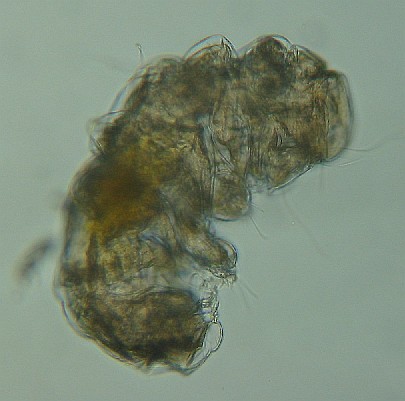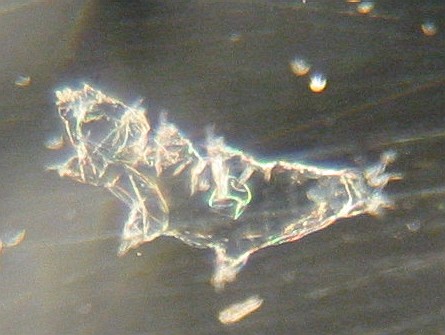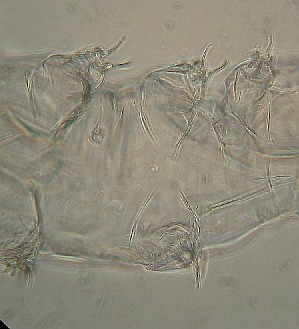| Atlantic |
 |
Site
Sample 00056. Photo on left is from Buena, NJ. Sample taken June 25, 2009.
Substrate was lichen on brick wall. 39 DEG 30.821 N, 074 DEG 55.541 W. Elevation
101 Ft. |
| Bergen |
 |
Site
Sample 00032. Photo on left is from Oakland, NJ. Sample taken June 4, 2004.
Substrate was lichen on tree bark. Possible "Hawthorn" tree. Leaf
sample taken and pressed. 41 DEG 00.150 N, 074 DEG 14.638 W. Elevation 418
Ft. |
| Burlington |


|
Site
Sample 00042. Photo on left from Unionville, NJ. Collected on Jan 11, 2006
from Maple tree lichen on bark. Maple tree assessment based upon dead leaves
on ground and tree structure. Two types of tardigrades found- Milnesium
(top left) and Ramazotius (bottom left). Found in suspension made on Jan
13, 2006. Site location- 40 DEG 01.118 N, 074 DEG 43.930 W, Elevation 84
Ft based upon GPS. |
| Camden |
 |
Site
Sample No. 00046. Photo on left of tardigrade from scraping of moss on bark
in Blue Anchor, NJ. Collected on 08AUG07, and suspension made on 14NOV07.
Permanent slide made 17NOV07, using double coverglass mount in PVA and Cytoseal
60. This is a stacked combination of 4 photos using Helicon Focus program,
and Sony Digital camera. Photo taken of tardigrade in PVA, and it looks
like it is molting- shedding its husk. Photo using oblique lighting, and
10WF objective with 10x Achromat. Location 39 DEG 39.604 N, 074 DEG 52.708
W. Elevation 139 Ft, using GPS. |
| Cape
May |
 |
Site
Sample No. 00045. Photo on left of tardigrade from scraping of bark from
American Holly (Ilex opaca) in So. Seaville, Sea Isle City, NJ. Collected
on 04MAR06, and suspension made on 02DEC07. Looks like Macrobiotus. Permanent
slide made 10DEC07, using double coverglass mount in PVA and Cytoseal 60.
This is a stacked combination of 4 photos using Helicon Focus program, and
Sony Digital camera. Image "reversed" in color using photo program.
Location 39 DEG 10.893 N, 074 DEG 43.400 W. Elevation 4 Ft, using GPS. |
| Cumberland |
 |
Site
Sample No. 00052. Photo on left of tardigrade from scraping of lichen from
headstone in Bridgeton Cemetery, Bridgeton, NJ. Collected on 25SEP07, and
suspension made on 14OCT07. Definitely Milnesium. Permanent slide made 25OCT07,
using double coverglass mount in Hoyers and Cytoseal 60. This is a stacked
combination of 4 photos using Helicon Focus program, and Sony Digital camera.
Location 39 DEG 25.736 N, 075 DEG 14.824 W. Elevation 86 Ft, using GPS. |
| Essex |
 |
Site
Sample No. 00035 collected on 05AUG2004. Photo on left is of West Orange,
NJ tardigrade. Definitely Milnesium. Also found in suspensions were Minibiotis.
Lichen scraped from bark of Scarlet Oak (Quescus coccinea). Suspension made
10MAR2008, and tardigrade found on 11MAR08. 40 DEG 46.072 N, 074 DEG 15.122
W. Elevation 216 Ft using GPS. |
| Gloucester |
 |
Site Sample
00047, from Downer, NJ collected on 08AUG07. Photo left taken on 10AUG07
from suspension made on 09AUG07 appears to be Macrobiotus. Tardigrade
immediately placed into PVA preservative, and permanently mounted on slide
before photo was taken. This is a multiple image photo with Helicon Focus
stacking program made from 4 photos. I'm noticing lens flare now, in all
of my shots with the new Sony digital camera. Although I'm getting more
megapixels (7 mp), the lens flare is a negative for this camera. Photo
below, in Darkfield, of another tardigrade found in this same suspension
on 13AUG07, and mounted in Hoyers. Also staked from 4 photos. Substrate
was White Oak tree (Quercus alba) and scraping was taken of moss
and lichen on bark. Location 39 DEG 41.349 N, 075 DEG 00.845W, elevation
91 Ft per GPS.

|
| Hudson |
 |
Site
Sample 00050, from Liberty State Park, Jersey City, NJ collected on 06SEP07.
Photo left taken on 03NOV07 from suspension made on 27OCT07. Two tardigrades
(in water) appear to be Macrobiotus and Minibiotus. Tardigrades placed into
PVA preservative under double coverglass, for permanent mounting on slide
after this photo was taken. Both PVA and Hoyers tend to clarify specimens
almost immediately, thus I took these photos while tartigrades in water
(See Bridgeton 00052 Cumberland Co. above for clarifying effect of mountant).
Site sample was bark scraping (not much noticable lichen at all) from London
Plane Tree, a type of Sycamore, Planatus x acerifolia. Location 40 DEG 41.655
N, 074 DEG 03.514 W, 0 (zero) ft. per GPS. |
| Hunterdon |
 |
Site
Sample No. 00037, from Flemington, NJ. Photo on left shows how a Macrobiotus
tardigrade appears in nature. Incident (or reflected) light had to be used.
Specimen, in a well slide, was lighted from below using oblique lighting
to illuminate the background and the sides of the bark substrate. A fiber
optic light cable was pointed above the specimen, while the origin end of
the cable was placed in contact at the flash of the camera. Since tardigrades
move rather quickly, the flash was able to stop the motion to a certain
extent, as well as light the subject as it would appear in daylight. Because
of the challenge of short working distance between the objective and coverglass
surface, I used a Lomo 10x plan objective. By selecting a 1.6x magnification
changer in the trinocular head, I was able to gain some additional magnification
without sacrificing working distance. Using a 10x WF eyepiece, the net result
is a magnification of 160 x. Observations and photos taken 22APR05. Sample
collected on 20APR05 from lichen covered bark of Pyrus communis (Common
Pear ) tree. Location 40 DEG 30.125 N, 074 DEG 51.295 W, 185 Ft. (GPS) |
| Mercer |
 |
Site
Sample No. 00041, from Robbinsville, NJ. Eyepiece 10xWF and objective25x
Zeiss achro. Permanent
slide made 17JAN08, using double coverglass mount in PVA and Cytoseal 60.
This is a stacked combination of 4 photos using Helicon Focus program, and
Sony Digital camera. Camera
camera was zoomed in to enlarge the specimen in the field. Sample
taken 01SEP05 from ground moss.
Location 40
DEG 13.703 N, 074 DEG 37.183
W, Elevation 67 Ft. (GPS). |
| Middlesex |
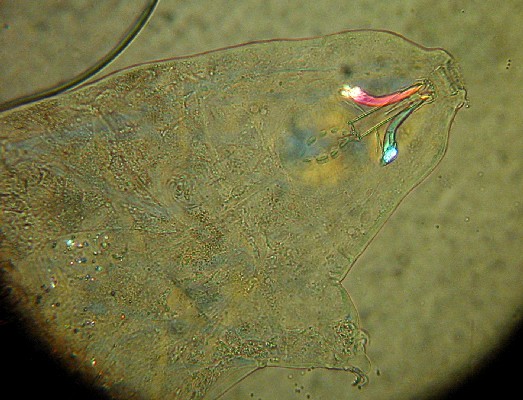
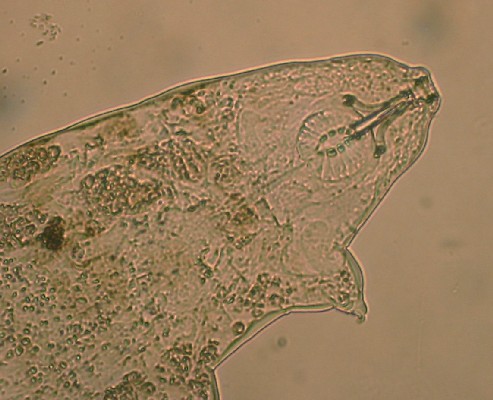
|
Site
Sample No. 00025. Photos on left are of East Brunswick, NJ tardigrade("Adler").
Eyepiece 10xWF and objective20x achro (top) and 40x achro (center and
bottom). Canon A40 digital camera was zoomed in to enlarge the specimen
in the field. Top two photos clearly show mouthparts and claws, indicating
this is a Macrobiotis.
Top left photo shows close up of head and mouth parts using crossed
polarization for a nice effect that illuminates the stylets. Stylets are
obviously bi-refringent. Macroplacoids look like that of Macrobiotus
harmsworthi. Observation and photos taken 25DEC03, with tardigrade
in water under cover glass. Sample
taken 19NOV03 from ground moss.
Location 40 DEG 26.881 N, 074 DEG 26.643 W, Elevation 71 Ft. (GPS).
Below
photo, of egg cluster. Site sample 00058, Woodbridge, NJ of 6/26/09. Used
40x Lomo objective and 10x WF eyepiece. Eggs mounted in PVA under coverglass.

|
| Monmouth |
 |
Site
Sample No. 00027, from Farmingdale, NJ. Photo to left shows good view of
Ramazzottuis tardigrade. Note the distinctive claw arangement of 2 short
, 1 long, and a short on each leg. Mouthparts very clear showing lips, which
look like short flexible duck-bill when viewed from various angles. Brown
markings on back also distinctive of Ramazzottius. Observation and photo
taken on 03JUL05 with Lomo trinicular and CanonA40, using 10x WF objective,
25x Zeiss achromat, and 1.1x magnification changer setting. Sample of lichen
covered bark from Liquidambar styraciflua (Sweetgum tree) was collected
on 24MAY04, and thus sat for an entire year before suspension was prepared.
Location 40 DEG 11.328 N, 074 DEG 09.838 W, 73 Ft. (GPS) |
| Morris |


|
Site Sample No. 00008.
Location is Morris Plains, NJ. Photos on left are of Metasequoia tardigrade
No. 1 ("META1"). Top- Eyepiece 10xWF and objective LOMO 20x Phase Contrast-
shows body shape and claws. Canon A40 digital camera was zoomed in to
enlarge the specimen in the field. Neutral Density#2 filter used. Bottom
left close up using 40x Phase objective and 100x Phase stop - shows mouthparts
and eyes. ND#2.
This specimen measured
370 microns. Observations showed the double claws and similar mouthparts
to possible Macrobiotis harmsworthii.
Sample taken18APR01, from
Metasequioa glyptostroboides (Dawn Redwood) tree bark. This bark
sample was kept in a zip-lock plastic bag for two years, and it took 3
weeks of soaking to re-hydrate the tardigrades. Observation and photos
made 06MAY03. Site location 40
DEG 50.455 N, 074 DEG 28.541 W, Elevation 413 Ft (GPS).
|
| Ocean |
 |
Site
Sample No. 00029. Sample
from Tom's River, NJ.
In photo on left, tardigrade eggs in shed husk or cuticle (molted skin
of a female), observed moving slightly, therefore viable. Also observed
in the same sample suspension was a live tardigrade (below) which looked
like Milnesium based upon claws. Milnesium also is known
to lay eggs in the shed cuticle. Hatched tardigrade in the restricted
well slide sample proved to be Milnesium. Photos using Canon A40
digital camera with 10x WF eyepiece and 10X Achromat objective. Used Rheinberg
center stop brown, and multicolor red/green annulus ring (left). Observations
and photos taken 20JUN - 22JUN04. Sample taken 25MAY04 from lichen on
Acer platanoides (Norway Maple) tree bark. Location 39 DEG 57.425
N, 074 DEG 10.296 W, Elevation 40 Ft. (GPS).

|
| Passaic |
  |
Site
Sample No. 00049. Photo on left is of Wayne, NJ tardigrade and egg. Eyepiece
10xWF and objective25x Zeiss achro. Sony Cybershot digital camera was use
in multiburst function to take multiple shots while refocusing through the
specimens. This allowed stacking using Helicon Focus program. Photo seems
to indicate this is a Macrobiotis. Observations and photos taken 23AUG07,
with tardigrade mounted in PVA under cover glass. Sample taken 20AUG07,
from moss and lichen scraped from bark of Quericus alba (White Oak) tree.
Location 41 DEG 00.0670 N, 074 DEG 16.516 W (GPS). |
| Salem |


|
Site Sample
No. 00018. Photo on left is of Auburn, NJ tardigrade ("Clara Barton").
Eyepiece 10xWF and objective20x achro. Canon A40 digital camera was zoomed
in to enlarge the specimen in the field. Photo seems to indicate this
is a Macrobiotis. Video taken as well. Click on the photo to see the AVI
format movie (+3 Mb ). Observations and photos taken13MAR04, with tardigrade
in water under cover glass. Sample taken 27OCT03, from lichen on bark
of Quericus palustris (Pin Oak) tree. Location 39 DEG 41.910 N, 075 DEG
23.746 W (GPS) .
Site Sample
No. 00054. Photo on left is of Salem, NJ tardigrade. Collected
on 25SEP07, and suspension made on 14OCT07. Definitely Milnesium. Permanent
slide made 25OCT07, using double coverglass mount in PVA and Cytoseal
60. This is a stacked combination of 4 photos using Helicon Focus program,
and Sony Digital camera. Oblique lighting with 10x WF eyepiece and 25x
Zeiss achomat objective. Location 39 DEG 34.209 N, 075 DEG 27.864 W. Elevation
22 Ft, using GPS.
|
| Somerset |
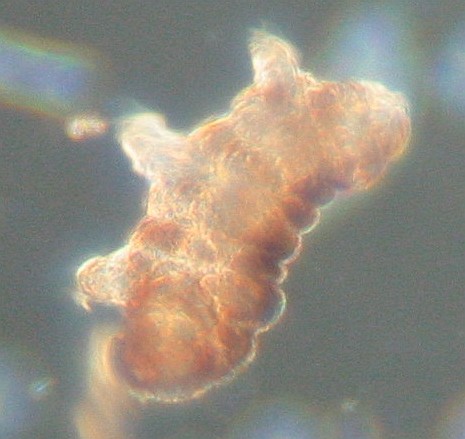

|
Site Sample No. 00007.
Photos to left are of Somerset, NJ tardigrade No. 2 ("Rama1"). Eyepiece
10xWF and objective LOMO 10x achro. Canon A40 digital camera was zoomed
in to enlarge the specimen in the field. These show body shape and rear
claws indicating Ramazzottius genus.Measured 279 microns. Digital
sharpening was used.
Photos
directly below are of Somerset, NJ tardigrade No. 1 ("Hairy Claws"). Eyepiece
10xWF and objective LOMO 10x achromat. Canon A40 digital camera was zoomed
in to enlarge the specimen in the field. Photo lower right of "Hairy
Claws" shows close up of head and mouth parts. Bottom photos on left
shows hair on the claws. Is this fungus? Mouthparts and size (372 microns)
indicate Macrobiotus genus. Macrobiotus hufelandi probable, based
on macroplacoids. Digital sharpening was used.
Specimen was taken from
Acer platanoides (Norway Maple) lichen on tree bark, on 30MAY03.
Observation and photos made 13JUN03. Location 40 DEG 34 min , 74 DEG 37
min (Aeronautical chart- Philadelphia VFR Terminal Area Chart 57th Ed.
February 20,2003).
|
| Sussex |


|
Site
Sample No. 00023. Above photo LEFT of Newton, NJ tardigrade ("Newco")
egg. Eyepiece 10xWF and objective20x achro. Egg looks like might be Macrobiotus
aerolatus (Kinchin). Egg spikes measure from tip to tip 14.6 micron. Egg
diameter measures from wall to wall 10.9 microns. Above photo RIGHT of
Newton, NJ tardigrade ("Newco"). Eyepiece 10xWF and objective20x
achro.Canon A40 digital camera was zoomed in to enlarge the specimen in
the field. Claw type seems to indicate this is a Macrobiotis, and
based upon macroplacoids, could be M. hufelandi. . Tardigrade length
measures 32.9 microns. Observations and photos taken 25JAN04, with tardigrade
in water under cover glass. Sample taken 14NOV03
from moss on rock surface. Location 41 DEG
02.866 N, 074 DEG 44.200 W, Elevation 623 Ft. (GPS).
|
| Union |


|
Site
Sample No. 00055. Photos on left are of Linden, NJ tardigrade. Collected
on 07APR08, from lichen on bark of unknown species of tree. Suspension made
on 11APR08. Definitely Milnesium. Permanent slide made 12APR08, using double
coverglass mount in PVA and Cytoseal 60. Each is a stacked combination of
4 photos using Helicon Focus program, and Sony Digital camera. Top is Brightfield
and bottom is Oblique lighting with 10x WF eyepiece and 25x Zeiss achomat
objective. Location 40 DEG 38.03 N, 074 DEG 16.17 W. Elevation 62 Ft, using
Magellan Topo Maps program to determine coordinates and elevation. |
| Warren |
|
Site
sample No. 00009. Below are two tardigrades from Hackettstown, NJ. Photos
of Tardigrade No.1 ("HACK1") is of a tardigrade cuticle or husk. The appearance
is of a dead tardigrade whose body is hollow. This is either a molted husk
or a deceased specimen, probably a shed husk because it has what looks like
an empty egg casing inside. This type of specimen is really easy to photograph
because live tardigrades move quickly! This specimen shows distinctive claw
set, and tapered body. Photos of Tardigrade No.2 ("HACK2") shows mouthparts.
This is probably Milnesium tardigradum. Smaller images with eyepiece
LOMO 10X WF and LOMO 10X achro objective. Brightfield with condenser iris
50% closed. Darkfield with iris open. Larger images with 10xWF eyepiece
and LOMO 40x Achro. Phase stops 20x and 40x used to enhance visibility of
claw sets. ND filter #2 used with Canon A40 digital camera. Digital sharpening
was used. Observations and photos made on 24APR03 from a sample of moss
growing on rock taken 02JUL02. Site location 40 DEG 54.244 N, 074 DEG 49.382
W (GPS) |


























